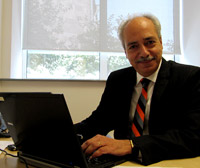Modern information and communication technologies allow us to transcend all limitations of time and distance.
All these technological features are being used by the Armenian Virtual College (AVC), the learning institute of the Armenian General Benevolent Union (AGBU) The goal of AVC is to establish education opportunities for all Armenians worldwide. The founding director of the Armenian Virtual College, Yervant Zorian said in a conversation with us that only 5% of Armenian children living out of Armenia have an opportunity to attend Armenian schools, which means there is a lack of Armenian education outside of Armenia. “The virtual college helps to keep the Armenian culture and language as it enables all Armenians in different corners of the world to have access to virtual classes,” said Y. Zorian. The AVC is currently comprised of three departments – Armenian language, Armenian history and Armenian culture. “Technological development enables us to implement virtual education, which means that students do not have to go to school and meet instructors face to face anymore. Due to distance learning we are delivering Armenian education everywhere and at any time,” says Y. Zorian. He says that the AGBU is the largest Armenian education institution out of Armenia, which has over 20 regular daily schools in different places of the world. The virtual college came true mostly due to the AGBU’s education expertise and financial support. Specialists and experts from different Armenian universities helped to develop the institutional capacity of the virtual college. Other virtual universities in the world have been examined as well for the purpose of taking the best practices and using them in the distance learning programs as well.
The learning courses in the virtual university are in different languages such as Armenian (Eastern and Western Armenian), English, Russian, French and Spanish. During the past months a course in Turkish has been developed, so that students can use Turkish to learn Armenian as well. “Armenians that have converted into Muslims in Turkey will have an opportunity to study Armenian using their Turkish,” said Zorian. Zorian also mentioned that that besides Armenians who are using Turkish to learn their language, there are also Turkish people who register to learn Armenian and get acquainted with our language and culture. Only the Armenian language course is taught through Turkish currently, but in September a course of Armenian history will be available in Turkish as well.
The Armenian Virtual College has students from 50 countries, but mostly the students come from the US (25%), followed by Georgia, France, Russia, Armenia, Canada, Uruguay, Argentina, etc. The fewest number of students come from Turkey. “There are students from countries with no Armenian communities, such as Réunion Island. There are four students from Shanghai, and only one of them is Armenian, while the others are wives of Armenians; they have got married to Armenians and started to learn Armenian,” said Zorian and added that the geography is growing year by year.
The courses are not free but…
AVC courses are not free; each course lasts three months and costs about 200 dollars. "Only about 5% of AVC costs are covered by student fees, while the remaining 95% is covered by sponsors," said Yervant Zorian, noting that the fee is symbolic. Many students receive scholarships as financial assistance, which covers the fee. This is especially true for socially vulnerable students with little or no income. Those with average income, pay about 50% of the tuition fee. In addition to this, there is a possibility of learning for free. If you have excellent grades at the end of the course, your tuition fee is refunded.
The biggest challenge of AVC is reaching out to people, who do not know about them. In words of Yervant Zorian the virtual college organizes virtual "travels" to Matenadaran or the Genocide Museum. "Our goal is not only to reach to Armenians, but also to inform those who are half or one quarter Armenian and to involve them in our educational processes which contribute to the preservation of the Armenian identity,” said Yervant Zorian. According to him, soon it will be possible to take AVC courses through mobile tools and devices. They are working on making it happen, so that starting from October students can have the opportunity to use those mobile tools.
Lusine MOVSISYAN

